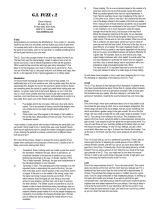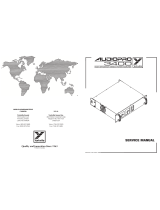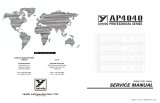Page is loading ...

Mini Fuzz Face
Vintage fuzz in a
neat little package
Contents of this document are ©2016 Pedal Parts Ltd.
No reproduction permitted without the express written
permission of Pedal Parts Ltd. All rights reserved.

IMPORTANT STUFF
Go no further until you’ve read this page.
TRANSISTORS
The PCB is designed for NPN transistors, i.e. standard negative-ground
configuration. You can use PNP transistors. See notes on capacitor orientation and
power supply.
You can experiment with any amount of different transistors. BC108 are supplied with
the kit if you’ve chosen a Silicon NPN build. AC128 will be supplied for Germanium
PNP versions.
If you’re building a classic germanium version, Transistor hFE values should be
approx:
Q1 - 70
Q3 - 100-120
To be honest, you’ll probably get satisfactory or even excellent results with different
values, but these are the generally accepted standard.
CAPACITOR ORIENTATION
C1 and C2 are oriented for NPN builds. If you’re building a PNP version you must
reverse these, i.e. long leg (+) in round pad.
SMOOTHING CAPACITORS
There are spots on the PCB for two extra caps - C4 and C5. These are optional
smoothing caps to tame the very high end of the signal and prevent potential squeal
and oscillation. They’re only really necessary when building the silicon version of the
circuit, but you can add them to a germanium build if you want to calm things down a
little. Values are down to personal taste. The higher the value, the more of the top
end frequency range you’ll cut out. Experiment with anything from 47p - 470p. For
BC108 builds our values would normally be 47p in C4, 220p in C5. Socket and
experiment.

Schematic NPN configuration shown
R1 100K
R2 33K
R3 470R (1K)
C1 2u2 electrolytic
C2 22 electrolytic
C3 10n
C4-5 See notes on previous page
BIAS 47K-50K Trimmer
Q1-2 See notes on previous page
FUZZ 1KB/1KC (2KB)
VOL 500KA
BOM
(Hendrix/Mayer changes shown in blue)
Adjust Q2 BIAS until it sounds sweet.
Q2 collector should be around 4.5V,
but trust your ears over numbers.
If you want to use PNP transistors
reverse the polarity of C1 and C2.

PCB Layout ©2015 Pedal Parts Ltd.
The power and signal pads on the PCB conform to the FuzzDog Direct
Connection format, so can be paired with the appropriate daughterboard for
quick and easy offboard wiring. If you’re building a PNP version be sure to check
the notes on the daughterboard document for reversing the polarity.
Ensure you keep your component leads trimmed tight to the PCB where they’re
located beneath the board-mounted pots, otherwise you may cause shorts.
The large locator tabs on the side of the pots don’t have to be used. They’ll be
sturdy enough with just the three front pins. Simply snip off the locator tabs if
you prefer not to use them.
Leave the pots until last, otherwise you’ll have
no access to other component pads.

Test the board!
NPN builds
UNDER NO CIRCUMSTANCES will troubleshooting help be
offered if you have skipped this stage. No exceptions.
Once you’ve finished the circuit it makes sense to test is before starting on
the switch and LED wiring. It’ll cut down troubleshooting time in the long
run. If the circuit works at this stage, but it doesn’t once you wire up the
switch - guess what? You’ve probably made a mistake with the switch.
Solder some nice, long lengths of wire to the board connections for 9V, GND,
IN and OUT. Connect IN and OUT to the jacks as shown. Connect all the
GNDs together (twist them up and add a small amount of solder to tack it).
Connect the battery + lead to the 9V wire, same method. Plug in. Go!
If it works, crack on and do your switch wiring. If not... aw man. At least you
know the problem is with the circuit. Find out why, get it working, THEN
worry about the switch etc.
BATTERY
IN OUT
Your nice, new circuit board
INCLUDING WIRED POTS!!!!
IN 9V GND OUT

Test the board!
PNP builds
UNDER NO CIRCUMSTANCES will troubleshooting help be
offered if you have skipped this stage. No exceptions.
Once you’ve finished the circuit it makes sense to test is before starting on the
switch and LED wiring. It’ll cut down troubleshooting time in the long run. If
the circuit works at this stage, but it doesn’t once you wire up the switch -
guess what? You’ve probably made a mistake with the switch.
Solder some nice, long lengths of wire to the board connections for -9V, GND,
IN and OUT. Connect IN and OUT to the jacks as shown. Connect all the GNDs
together (twist them up and add a small amount of solder to tack it). Connect
the battery - lead to the -9V wire, same method. Plug in. Go!
If it works, crack on and do your switch wiring. If not... aw man. At least you
know the problem is with the circuit. Find out why, get it working, THEN worry
about the switch etc.
BATTERY
IN OUT
Your nice, new circuit board
INCLUDING WIRED POTS!!!!
IN -9V GND OUT

Wire it up (if using a daughterboard please refer to the relevant document)
Wiring shown above will disconnect the battery when you remove the jack
plug from the input, and also when a DC plug is inserted.
The Board GND connections don’t all have to directly attach to the board. You
can run a couple of wires from the DC connector, one to the board, another to
the IN jack, then daisy chain that over to the OUT jack.
It doesn’t matter how they all connect, as long as they do.
This circuit is standard, Negative GND. Your power supply should be Tip
Negative / Sleeve Positive. That’s the same as your standard pedals (Boss etc),
and you can safely daisy-chain your supply to this pedal.
PedalParts.co.uk
L
E
D
BOARD
OUT
BOARD
9V
BOARD
GND
BOARD
GND
BOARD
GND
BOARD
INPUT
BATTERY
+
IN
OUT
L
E
D
BOARD
GND
BOARD
9V
+
NPN

Wire it up (if using a daughterboard please refer to the relevant document)
Wiring shown above will disconnect the battery when you remove the jack
plug from the input, and also when a DC plug is inserted.
The Board GND connections don’t all have to directly attach to the board. You
can run a couple of wires from the DC connector, one to the board, another to
the IN jack, then daisy chain that over to the OUT jack.
It doesn’t matter how they all connect, as long as they do.
This circuit is standard, Negative GND. Your power supply should be Tip
Negative / Sleeve Positive. That’s the same as your standard pedals (Boss etc),
and you can safely daisy-chain your supply to this pedal.
PedalParts.co.uk
BOARD
OUT
BOARD
-9V
BOARD
GND
BOARD
GND
BOARD
INPUT
BATTERY
IN
OUT
BOARD
GND
+
L
E
D
+L
E
D
BOARD
-9V
PNP
/













